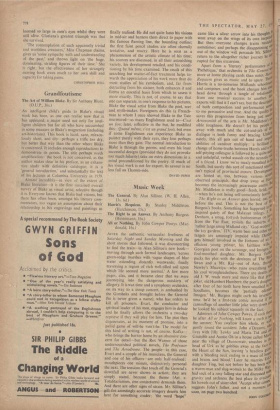Grandfoutisme
The Art of William Blake. By Sir Anthony Blunt. (O.U.P., 36s.)
AN intelligent child's guide to Blake's visual work has been, as one can realise now that it has appeared, a major need not only for intel- ligent children but for all who have succumbed in some measure to Blake's magnetism (including art-historians). This book is lucid, sane, miracu- lously short, and dry—perhaps a trifle too dry, but better that way than the other where Blake is concerned. It includes enough reproductions to demonstrate its points. The title perhaps needs amplification : the book is not conceived, as the author makes clear in his preface, as an exhaus- tive study with definitive catalogue; it is a 'general introduction,' and substantially the text of his lectures at Columbia University in 19,59.
Almost incredibly—in view of the extent of Blake literature—it is the first sustained overall survey of Blake as visual artist, selective though it is. Everyone knows that Blake had visions, but there has often been, amongst his literary com- mentators. too vague an assumption about their relationship to his engravings and paintings as finally realised. He did not quite lasso his visions in mid-air and harness them direct to paper with the famous flaming line, the bounding outline; the first faint pencil studies are often clumsily tentative, and muzzy. Here he is seen as a phenomenon of the artistic climate of his time; his sources are discussed, in all their astonishing variety, his development retailed, and his condi- tioning by his time examined. The result of this searching but matter-of-fact treatment helps to- wards the appreciation of his work more than do most studies of his symbolism, and, far from detracting from his stature, both enhances it and forms an essential basis from which to assess it more exactly. This is not, of course, to say that one can separate, in one's response to his pictures, Blake the visual artist from Blake the poet, seer and myth-maker. Foreigners do this (a French- man to whom I once showed Blake in the Tate murmured—as many Englishmen used to—C'est un fou: later, reflective in the bus, he modified this: Quand mime, c'est un grand foil), but even if some Englishmen can experience Blake as painter purely with their eyes, they lose perhaps more than they gain. The normal introduction to Blake is through the poems, and even his least successful designs (provided they do not provoke too much hilarity) take on extra dimensions in a mind preconditioned by the poetry. If much of his visual work is not for export, its savour is no less full on Thames-side.
DAVID PIPER






































 Previous page
Previous page